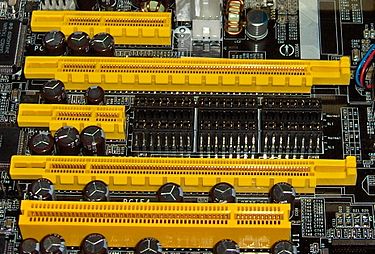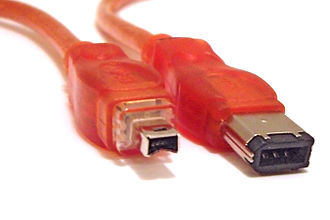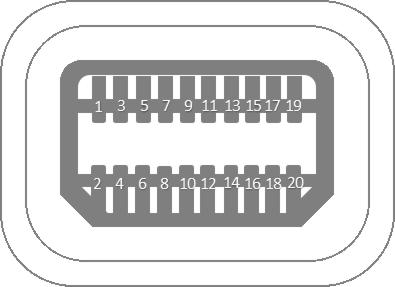Back
Next
General purpose port.
Wide range of controls and broad protocol.
Bi-directional data transfer or 'lanes' with paths in both directions.
Common ports
PCI-e - hardware point to point. Software multi-port.
internal - but external extension available.
PCI-e uses lanes, 2 pair of lines make up a lane.
one pair for sending, one for receiving.
Lanes are expanded in powers of 2, 1, 2, 4, 8, 16, 32
16x max on most PCs.
 * bottom slot is standard PCI interface.
SATA - storage device interface, Hard drives, CD, DVD, Blu-Ray, SSD
Limited protocol. internal.
* bottom slot is standard PCI interface.
SATA - storage device interface, Hard drives, CD, DVD, Blu-Ray, SSD
Limited protocol. internal.
 eSATA - external interface.
USB - hardware point to point. Software multi-port. External.
Requires master.
IEEE 1394 (Fire-wire or i.LINK) - alternative to USB. External.
Initially more advanced, built on SCSI protocols.
Uses arbitration - any device may be master.
eSATA - external interface.
USB - hardware point to point. Software multi-port. External.
Requires master.
IEEE 1394 (Fire-wire or i.LINK) - alternative to USB. External.
Initially more advanced, built on SCSI protocols.
Uses arbitration - any device may be master.
 Thunderbolt - combination of Display Port and PCI-e and DC power.
External.
Thunderbolt - combination of Display Port and PCI-e and DC power.
External.
 Up to 4 lanes of data transfer.
2 duplexed lanes (10 Gib/s per lane) in Thunderbolt mode.
(20 Gib/s max in each direction).
Originally designed for optical cabling but copper works fine.
* Some of these can use hub or daisy chain implementation allowing a
single port from controller to multiple devices.
Addressing usually implemented via software packets.
Up to 4 lanes of data transfer.
2 duplexed lanes (10 Gib/s per lane) in Thunderbolt mode.
(20 Gib/s max in each direction).
Originally designed for optical cabling but copper works fine.
* Some of these can use hub or daisy chain implementation allowing a
single port from controller to multiple devices.
Addressing usually implemented via software packets.
 * bottom slot is standard PCI interface.
SATA - storage device interface, Hard drives, CD, DVD, Blu-Ray, SSD
Limited protocol. internal.
* bottom slot is standard PCI interface.
SATA - storage device interface, Hard drives, CD, DVD, Blu-Ray, SSD
Limited protocol. internal.
 eSATA - external interface.
USB - hardware point to point. Software multi-port. External.
Requires master.
IEEE 1394 (Fire-wire or i.LINK) - alternative to USB. External.
Initially more advanced, built on SCSI protocols.
Uses arbitration - any device may be master.
eSATA - external interface.
USB - hardware point to point. Software multi-port. External.
Requires master.
IEEE 1394 (Fire-wire or i.LINK) - alternative to USB. External.
Initially more advanced, built on SCSI protocols.
Uses arbitration - any device may be master.
 Thunderbolt - combination of Display Port and PCI-e and DC power.
External.
Thunderbolt - combination of Display Port and PCI-e and DC power.
External.
 Up to 4 lanes of data transfer.
2 duplexed lanes (10 Gib/s per lane) in Thunderbolt mode.
(20 Gib/s max in each direction).
Originally designed for optical cabling but copper works fine.
* Some of these can use hub or daisy chain implementation allowing a
single port from controller to multiple devices.
Addressing usually implemented via software packets.
Up to 4 lanes of data transfer.
2 duplexed lanes (10 Gib/s per lane) in Thunderbolt mode.
(20 Gib/s max in each direction).
Originally designed for optical cabling but copper works fine.
* Some of these can use hub or daisy chain implementation allowing a
single port from controller to multiple devices.
Addressing usually implemented via software packets.